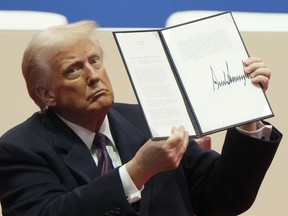Trump signed 220 during his first term. This time around, he signed 26 on his first day

Much has been made of the U.S. presidential tool known as an executive order in recent days.
Recommended Videos
Just hours after his inauguration on Monday, newly ensconced President Donald Trump signed several executive orders aimed at — among other things — immigration, oil and gas production, renaming Denali mountain in Alaska and the Gulf of Mexico, as well as pardoning most of the people charged or convicted in the Jan. 6, 2021 attack on the U.S. Capitol.
Here’s what to know about executive orders.
What is an executive order?
Executive orders are not legislation. They don’t require approval from Congress. Likewise, Congress cannot simply overturn them.
They are more akin to announcements setting out how the president wants the U.S. government to move forward –- in effect, they are instructions for government departments and agencies.
Can executive orders be countered?
Executive orders can play a key role for a president intent on aims that the U.S. Congress could balk at.
That’s not to say the president would use executive orders to, in effect, go rogue. Instead, Congress could push back, for example by refusing necessary funding required to pursue an agenda item.
“We have to relate as equals, not subordinates,” Mexican President Claudia Sheinbaum said on Tuesday, reacting to the executive orders regarding the shared border. She noted that Trump already proclaimed a national emergency at the southern border during his first presidency. As far as changing the name of the Gulf of Mexico, she said, “For us and the world, it is still the Gulf of Mexico.”
How many will a president sign during his or her term?
Franklin Delano Roosevelt (a four-term president from 1932 to 1945) still holds the all-time record, issuing 3,721 executive orders.
How are executive orders documented?
How is power exerted differently in Canada?
The difference in the two tools reflects the differences in our respective government structures.
For example, unlike the U.S. president a Canadian prime minister is not elected to the top leadership post directly. Instead, a prime minister attains his or her position by winning the leadership of the governing party. A U.S. president’s party may not even be in control of the American congress or one of its parts — the House of Representatives or Senate.
The Canadian prime minister can appoint his or cabinet ministers without any concern about confirmation by the Senate. We are seeing the opposite process playing out in the American Senate now.
An American president is Commander-in-Chief of the Armed forces, but only Congress can declare war. In Canada, the federal government issues formal declarations of war. However, the prime minister is not head the Canadian Armed Forces.
There are no term limits for Canadian prime ministers, whereas an American president can only serve two terms.
Our website is the place for the latest breaking news, exclusive scoops, longreads and provocative commentary. Please bookmark nationalpost.com and sign up for our daily newsletter, Posted, here.